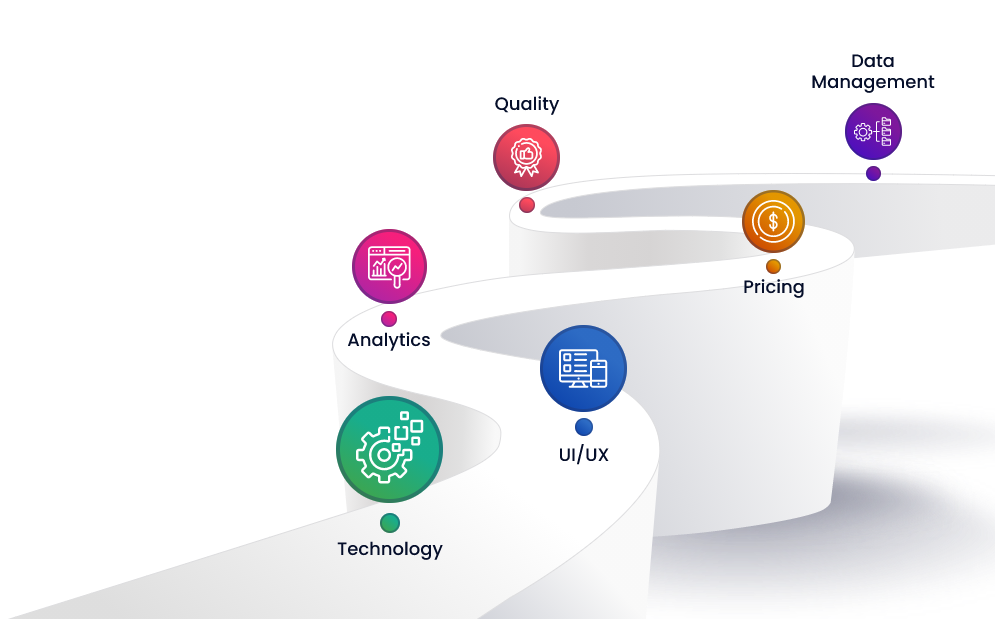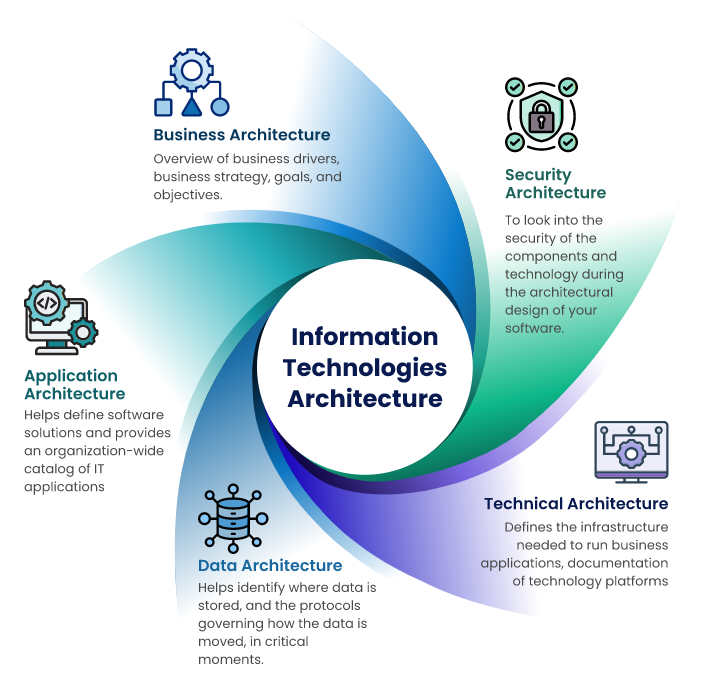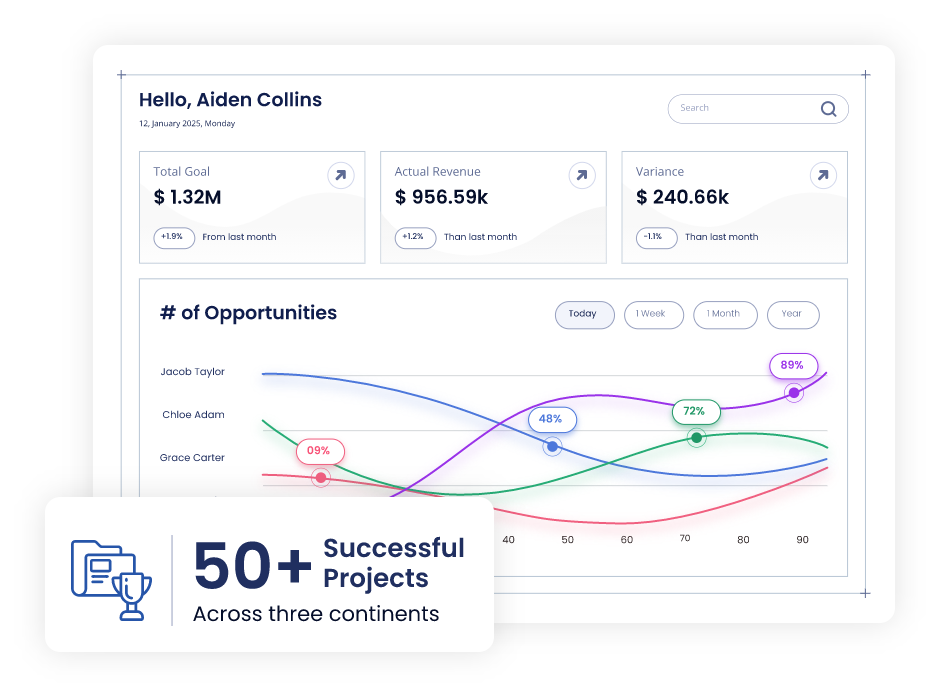IT Advisory Services
Practical guidance backed by Microsoft technologies.
At Alphavima, we do more than deliver technology-we help you make decisions that matter. Our advisory services are rooted in honest conversations, clear strategies, and a realistic view of how technology impacts your business operations.
How We Help
We provide practical solutions to your business challenges with Microsoft technologies
tailored to your specific needs.
Technology Roadmap
We help organizations chart a clear path forward with their digital strategy, ensuring technology investments align with business goals.
Common Pain Points
- Unclear digital strategy
- Tool sprawl and redundancy
- Misalignment between IT & business goals
Our Solutions
- Comprehensive roadmap development
- Cloud migration planning (Azure, Dynamics 365)
- Risk assessment and timeline planning
Technology Roadmap Visualization

IT Architecture
We design robust, scalable IT architectures that connect your systems and unlock the value of your data.
Common Pain Points
- Siloed systems and disconnected data
- Legacy systems limitations
- Poor data flow between departments
Our Solutions
- Architecture assessment and redesign
- Dataverse integration for unified data
- Cross-team connectivity solutions
System Architecture Visualization

Microsoft Licensing Advisory & Management
We help you navigate Microsoft’s complex licensing landscape to optimize costs while ensuring compliance.
Common Pain Points
- License sprawl and underutilizatio
- Renewal confusion and negotiation challenges
- Overspending on unnecessary licenses
Our Solutions
- Usage analysis and compliance verification
- CSP/EA program guidance and negotiation
- License audits and optimization
License Optimization Dashboard

Talent Advisory Support
We help you build and maintain the right technical team to support your Microsoft technology investments.
Common Pain Points
- Hard-to-fill technical roles
- Skill gaps in existing teams
- Challenges scaling teams with workload
Our Solutions
- Technical role definition and skill mapping
- Skills alignment and training recommendations
- Hiring and onboarding advisory services
Microsoft Skills Gap Analysis

What Sets Us Apart
business outcomes.
Industry Insight
Experience in manufacturing, nonprofit, rental, healthcare, and utilities sectors.
Client-First Approach
Custom strategies built around your specific business needs and goals.
Lean, Capable Team
Engineers and advisors with real-world delivery experience, not just theory.
Proven Delivery Experience
Successfully completed projects with 50+ clients across North America, Europe, and Asia.
Flexible Support
From one-time strategy sessions to long-term advisory partnerships.

Why Work with Us
solutions that deliver real value.
Our Microsoft Expertise
Areas we specialize in:
Microsoft Dynamics 365
CRM, ERP, Customer Service, Field Service
Power Apps, Automate, BI, Virtual Agents
Azure Infrastructure
Microsoft Fabric and Dataverse
Integration Services
Microsoft Dynamics 365
Let’s talk about what’s working, what isn’t, and how to move forward together.
Ready to Transform Your Microsoft Technology Strategy?
Schedule a no-obligation consultation with our advisory team to discuss your specific needs and how we can help you make more informed technology decisions.
- Get practical advice from certified Microsoft experts
- Customized recommendations for your business goals
- Clear next steps with actionable insights

Use Cases
Helping Organizations Deliver Results
Industry Solutions
We develop customized Power Platform solutions across various industries, addressing specific challenges and
delivering measurable outcomes. Explore how our expertise translates to your sector.

Manufacturing
Streamline operations, improve quality control, and optimize production workflows with custom Power Platform solutions.
Production Optimization
Real-time monitoring and predictive maintenance
Equipment Monitoring
Real-time dashboards with maintenance alerts
Quality Control
Automated inspection workflows with photo capture
Supply Chain Integration
End-to-end visibility and inventory optimization

Retail
Digitize customer interactions, optimize inventory flows, and drive smarter promotions using Microsoft Power Platform.
Customer Engagement Hub
Personalized shopping experiences and loyalty programs
Store Analytics
Real-time customer behavior dashboards across locations
Loyalty Management
Power Apps for tracking rewards, redemptions, and segmentation
Promotion Performance
Automated tracking of campaigns and real-time ROI dashboards

Utility & Power
Enable connected operations, regulatory compliance, and predictive analytics with cloud-first Power Platform solutions.
Smart Utility Operations
Connected field operations and compliance reporting
Asset Lifecycle Monitoring
Real-time dashboards for field equipment and preventive alerts
Regulatory Reporting
Power BI dashboards with export-ready compliance formats
Service Scheduling
Automated job allocation and routing with Power Automate

Rental Business
Manage the full lifecycle of assets, billing, and service requests from one Power Platform-backed solution.
Connected Rental Management
Asset tracking and service management
Asset Tracking
Dashboards for location, status, and availability
Advanced Billing
Automated invoicing and payment reminders via Power Automate
Service Dispatching
Field techs use Power Apps for inspections and servicing

Education
Track student outcomes, automate academic workflows, and improve data transparency across departments.
Academic Process Optimization
Streamlined workflows and data-driven insights
Student Case Management
Power Apps for tracking academic support and interventions
Program Analytics
Dashboards on enrollments, graduation rates, and outcomes
Document Workflow
Automated transcript, application, and approval flows

Homeowner Insurance
Offer a seamless, self-service experience to homeowners, builders, and customer support teams.
Self-Service & Case Management
Streamlined support and warranty tracking
Warranty Case Tracking
SLA-driven support systems with Power Apps and Power Pages
Self-Serve Portals
Builders and homeowners log and track cases independently
Customer Analytics
Power BI views of case volumes, timelines, and satisfaction

Mining
Enhance operational safety, environmental tracking, and site visibility using Microsoft's modern data platform.
Mine Site Digitization
Safety tracking and environmental compliance
Inspection Logs
Power Apps-based safety checks with image and location capture
Environmental Compliance
Power BI dashboards to track emissions and audit logs
Resource Tracking
Realtime dashboards for material movement and equipment use

Nonprofit Solutions
Digitize customer interactions, optimize inventory flows, and drive smarter promotions using Microsoft Power Platform.
Customer Engagement Hub
Personalized shopping experiences and loyalty programs
Store Analytics
Real-time customer behavior dashboards across locations
Loyalty Management
Power Apps for tracking rewards, redemptions, and segmentation
Promotion Performance
Automated tracking of campaigns and real-time ROI dashboards
Success Stories
Real organizations achieving real results with Power Platform solutions

M&GN Joint Railway Society.
United Kingdom
CRM & Member Portal Transformation
- Replaced legacy spreadsheets with Power Platform
- Reduced onboarding time by 65%
- Enhanced security with proper access controls
Before vs. After
Before
- Manual Excel spreadsheets
- Duplicate member entries
- No self-service options
- Limited reporting capabilities
After
- Centralized member database
- Automated renewal workflows
- Self-service member portal
- Real-time business insights
Solutions used:

Canadian Wildlife Federation
Canada
Membership & Donation Tracking System
- Automated membership renewal system
- Increased renewal rates by 32%
- Reduced manual data errors by 87%
Before vs. After
Before
- Multiple disconnected systems
- Manual donation processing
- Delayed reporting cycles
- Limited donor insights
After
- Unified CRM platform
- Automated donation receipts
- Real-time campaign tracking
- Donor segmentation & analysis
Solutions used:

Custom Truck One Source
Kansas City, USA
Unified Reporting & Data Warehouse
- 15 days of manual reporting reduced to automated real-time dashboards
- Improved visibility across multiple ERPs
- Significant cost savings through process optimization
Before vs. After
Before
- Manual, Excel-based reporting
- Multiple disconnected ERP systems
- Data silos and inconsistencies
- Delayed decision-making
After
- Centralized data warehouse
- Automated data ingestion pipelines
- Real-time Power BI dashboards
- Improved accuracy in business reporting
Solutions used:

Walmart Labs Canada
Canada
AdTech Platform Modernization
- Built digital marketing platform using Google Cloud & Power BI
- Created single customer view & improved campaign targeting
- Boosted customer engagement with advanced insights & automation
Before vs. After
Before
- Multiple systems with disjointed customer data
- No audience targeting for campaigns
- Poor visibility into customer behavior
- No abandoned cart tracking
After
- Unified customer data across online & in-store
- Rule-based audience generation engine
- Real-time insights via Power BI
- Integrated tracking and campaign retargeting
Solutions used:

Custom Truck One Source
Kansas City, USA
ERP Data Migration & Integration
- Seamless migration of legacy data from multiple ERPs
- Comprehensive data integrity and audit validation
- Continuous integration ensured business continuity during transition
Before vs. After
Before
- Multiple ERPs with incompatible data structures
- Poor data quality & late evaluations
- Complex, high-volume data with no integrity checks
- Risk of downtime during migration
After
- Unified schema with transformed data
- Validated & reconciled clean datasets
- Auditable migration algorithms and mappings
- Incremental batch loads and continuous sync
Solutions used:

TD Securities
Canada
Risk & Regulatory Reporting Platform
- Consolidated over a billion daily records into a single risk platform
- Enabled early risk detection with threshold-based alerting
- Improved compliance and governance across trade reporting
Before vs. After
Before
- No unified risk reporting platform
- Processing over 1B records/day with performance issues
- Lack of early risk detection
- Regulatory misalignment
After
- Centralized risk reporting across LOBs
- Scalable Hadoop + Spark intake framework
- Threshold-based rule engine for anomaly detection
- Governance-ready reporting architecture
Solutions used:

Pro Bono Law Alberta
Canada
Client & Volunteer Management Automation
- Streamlined volunteer and client workflows through Power Platform
- Improved data visibility and document control with e-signature integration
- Boosted engagement through real-time dashboards and analytics
Before vs. After
Before
- Manual, tedious client and volunteer management
- Scattered and siloed data
- No electronic signature or streamlined document process
- No consolidated reporting
After
- Automated workflows and scheduling
- Centralized, searchable database
- Docusign-powered digital documentation
- Interactive dashboards with activity tracking
Solutions used:

Oakville Enterprises Corporation (OEC)
Canada
ERP Modernization & Utility Analytics with Olix365
- Implemented scalable ERP solution for optimized utility operations
- Enabled real-time reporting with regulatory-focused analytics
- Enhanced integration and performance across business processes
Before vs. After
Before
- Dispersed data across business units
- Poor ERP governance and system performance
- Manual utility reporting processes
- Limited remote accessibility
After
- Centralized ERP with optimized integration
- Scalable system with improved efficiency
- Real-time reporting with utility analytics
- Full mobility and remote access enabled
Solutions used:

Professional Warranty Services Corporation (PWSC)
Chantilly, VA, USA
CRM & Claims Transformation with Dynamics 365
- Unified sales, warranty, and claims into a single CRM system
- Enabled self-serve portals for homeowners and builders
- Reduced time-to-market for new insurance products
Before vs. After
Before
- Multiple systems to manage sales and claims
- No flexibility to add new products
- No self-service portal for builders/homeowners
- Manual and undefined claims processing
After
- Centralized Dynamics 365 CRM
- Flexible, data-driven architecture
- Self-serve portals for reduced support load
- Structured claims workflows with SLA tracking
Solutions used:

Brigham Young University (BYU)
Provo, Utah, USA
Campus-Wide ERP & Inventory Modernization
- Enabled robust, real-time inventory and rental tracking across departments
- Integrated Workday with a scalable PREXA365 solution
- Improved planning, visibility, and reporting for asset and project management
Before vs. After
Before
- Legacy PeopleSoft system with limited functionality
- Critical Workday gaps for inventory & rental
- No asset tracking or consolidated visibility
- Disconnected financial/procurement systems
After
- Modern campus-wide PREXA365 inventory & rental system
- Real-time integration with Workday
- Asset tracking and centralized reporting
- Unified, scalable solution across departments
Solutions used:
What Our Clients Say
Be inspired by our clients’ journeys as we overcome challenges and achieve success together.
Pedro
West York Rentals

Chad Jones
Managing Partner | SME | Integrator, Caprock Rentals, USA

Pascale Décosse Léger
Communication Director, SBC

Anick Silencieux
Executive Director, SBC


Holly Evans
Patient Support Officer, PC Project

Janice Schwartz
Executive Director, PC Project

Shan Abbasi
Manager, Community Engagement, Volunteer MBC




